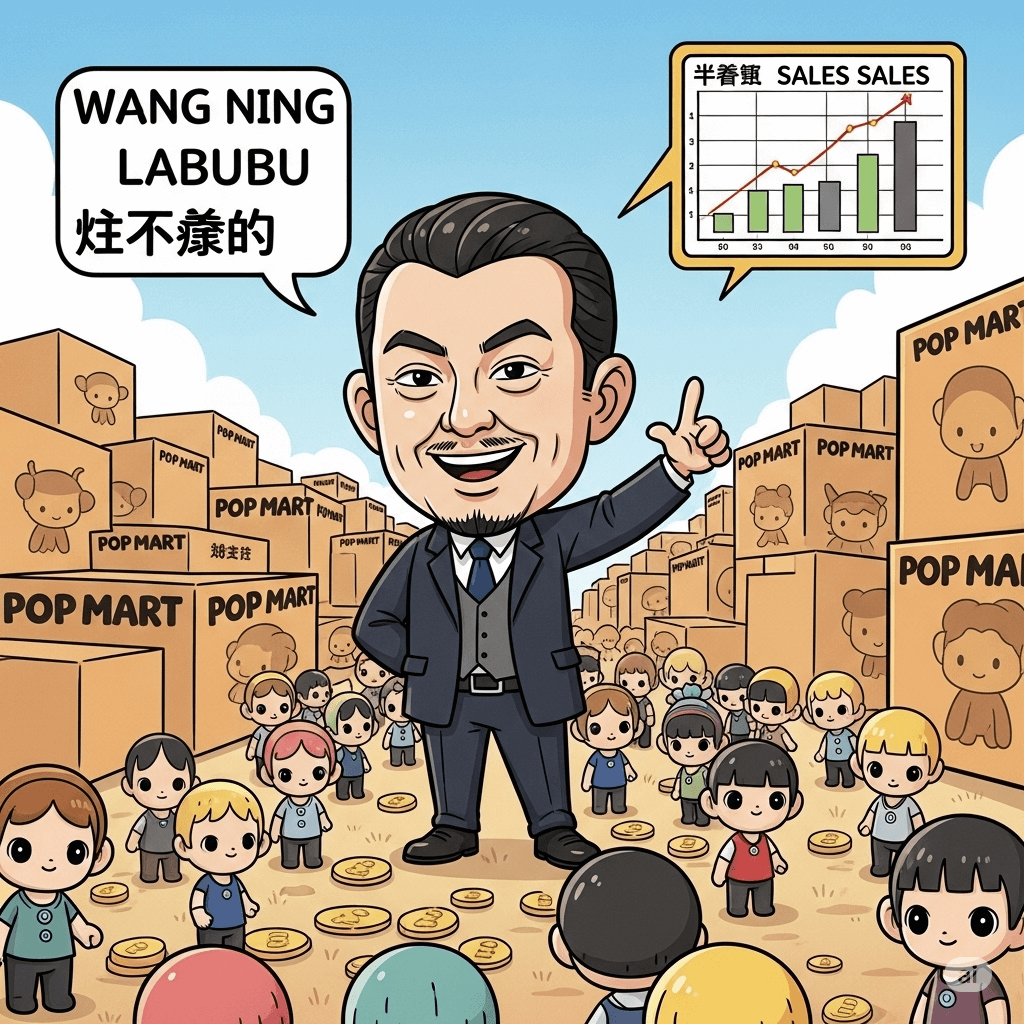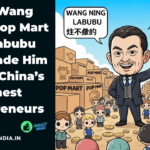You don’t have to look far to understand what’s happening here. Labubu, the wild-eyed, sharp-toothed doll with a cult following, has exploded into one of the biggest global toy sensations in recent years. Originally a character from a Nordic-inspired picture book, Labubu now sits at the center of a billion-dollar collectibles empire—powered by Wang Ning’s Pop Mart, a company that turned a blind box retail model into a cultural movement.
This isn’t just about toys anymore. It’s about branding, obsession, and a masterclass in building emotional loyalty among Gen Z and millennial collectors.
- From Picture Book to Global Sensation: The Rise of Labubu
- The Marketing? Genius. The Demand? Unbelievable.
- How Labubu Drove Pop Mart’s Financial Surge
- Wang Ning: From Ad Exec to One of China’s Richest
- What Indian Entrepreneurs Can Learn
- FAQ (Frequently Asked Questions)
- 1. What is Pop Mart and why is it so popular?
- 2. Who is Wang Ning, the founder of Pop Mart?
- 3. What is Labubu and why is it so valuable?
- 4. Is Pop Mart available in India or globally?
- 5. Are Pop Mart toys suitable for kids or collectors?
- 6. How is Pop Mart responding to regulatory pressure in China?
- 7. What lessons can Indian entrepreneurs learn from Wang Ning’s Pop Mart?
From Picture Book to Global Sensation: The Rise of Labubu

Labubu, a mischievous character born out of illustrator Kasing Lung’s imagination, was originally just a quiet resident of a picture book inspired by Nordic tales. But fast forward to 2025, and Labubu isn’t just a character—it’s a cultural icon. It’s the face of Pop Mart’s success.
If you’re unfamiliar with Pop Mart’s business model, here’s the hook: you don’t get to choose your toy. You buy a sealed “blind box,” and what you get is random. It’s like opening a pack of Pokémon cards or rolling the dice in a casino, except the stakes are cuteness, collectibility, and community clout.
And guess what? This randomness is exactly what made Wang Ning’s Pop Mart explode. In an era dominated by over-choice and digital fatigue, a physical box filled with surprise offers just the right hit of dopamine.
The Marketing? Genius. The Demand? Unbelievable.
The Labubu wave didn’t rise on its own. It was fueled by social media. You scroll through TikTok or Instagram, and there’s Labubu — featured in unboxing videos, on fashion shoots, and more importantly, in the hands of stars like Lisa from BLACKPINK, Rihanna, and Dua Lipa.
That’s not coincidence. That’s brilliant placement.
What followed next was a collector’s dream: limited edition Labubu dolls began selling for over $100,000 in secondary markets. In the U.S., fans have been queuing up outside Pop Mart stores just to get their hands on new releases. And in London, the third edition Labubu drop caused scuffles at the store with fans scrambling to pay up to £50 (₹5,000) for one doll.
Even banks are getting in on the action—Ping An Bank in China offered Labubu dolls to customers opening new accounts with deposits above 50,000 yuan. When banks start offering toys as perks, you know the brand has cracked the cultural code.
How Labubu Drove Pop Mart’s Financial Surge
The Labubu craze has directly boosted Pop Mart’s financial success. The company, listed on the Hong Kong Stock Exchange (SEHK: 9992), saw its market cap soar past HKD 336 billion, with 2024 revenue exceeding 13 billion yuan ($1.8 billion). The “The Monsters” series, featuring Labubu, contributed over 3 billion yuan alone.
However, the rapid growth has also drawn regulatory scrutiny. Chinese authorities have raised concerns about blind box addiction among children, leading to a temporary stock dip in June 2025. Despite this, demand remains sky-high.
Wang Ning: From Ad Exec to One of China’s Richest
Behind all this is Wang Ning, who founded Pop Mart in 2010 after a stint in advertising at Sina Corporation. He understood something few did at the time—China didn’t just need more toys; it needed better stories, better experiences.
Fast forward to 2025, Wang now owns 48.7% of the company and boasts a personal net worth of $22.7 billion (₹1.89 lakh crore). That puts him in China’s Top 10 Richest, a leap fueled entirely by a toy rabbit that nobody saw coming.
He led Pop Mart’s IPO in Hong Kong in 2020, raising $676 million, and has since built a distribution empire with 400+ physical stores and 2,300+ “roboshops” (automated vending machines) spread across China and international markets.
But Wang isn’t just selling dolls—he’s building an intellectual property ecosystem. From Coca-Cola collaborations to Disney tie-ins and One Piece licensing, Pop Mart is pushing beyond toys into full-fledged storytelling and merchandising.
What Indian Entrepreneurs Can Learn
For Indian founders and marketers, Wang Ning’s Pop Mart offers a playbook worth studying.
- Embrace the unexpected. A toy no one bet on has now become a cultural status symbol.
- Design for emotion, not just utility. Labubu isn’t valuable because of materials—it’s about what it represents.
- Make scarcity your strategy. Blind boxes + limited editions = sky-high demand.
- Use social media like a stage. Celebrity partnerships weren’t gimmicks—they were tactical.
- Build IP, not just products. The real goldmine lies in owning characters, not just selling merchandise.
FAQ (Frequently Asked Questions)
1. What is Pop Mart and why is it so popular?
Pop Mart is a Chinese toy company best known for its “blind box” collectibles—sealed packages that contain a random toy figure. Its popularity skyrocketed due to the thrill of surprise, limited editions, and viral social media buzz, especially surrounding characters like Labubu, which has become a global sensation.
2. Who is Wang Ning, the founder of Pop Mart?
Wang Ning is a Chinese entrepreneur and the CEO of Pop Mart. He launched the company in 2010 and led it to global prominence with the blind box model. As of 2025, he’s one of the Top 10 richest people in China, with a net worth of $22.7 billion, largely thanks to the explosive success of Labubu dolls.
3. What is Labubu and why is it so valuable?
Labubu is a mischievous, rabbit-like character created by artist Kasing Lung. Originally featured in a children’s picture book, it became a breakout hit under Pop Mart. Some limited-edition Labubu dolls now sell for over $100,000 in secondary markets, driven by scarcity, celebrity endorsements, and collector culture.
4. Is Pop Mart available in India or globally?
Yes, Pop Mart has expanded globally with hundreds of stores and over 2,300 “roboshops” (toy vending machines). While it doesn’t have a full retail presence in India yet, Indian fans can buy collectibles via international e-commerce platforms or reseller markets. Expect expansion in Asia-Pacific regions soon.
5. Are Pop Mart toys suitable for kids or collectors?
While Pop Mart toys may look child-friendly, they’re primarily designed for adult collectors, especially millennials and Gen Z audiences. The element of surprise and the limited-edition drops cater more to collectible culture than casual play.
6. How is Pop Mart responding to regulatory pressure in China?
Chinese regulators have expressed concern about the psychological impact of blind box purchasing among children. In response, Pop Mart is expected to increase transparency, age restrictions, and ethical marketing practices. News of regulatory review briefly impacted its stock in June 2025.
7. What lessons can Indian entrepreneurs learn from Wang Ning’s Pop Mart?
Wang Ning’s Pop Mart teaches us the power of IP-driven branding, the value of emotional storytelling, and the potential in building ecosystems around niche products. It’s a reminder that even a toy can become a billion-dollar business when backed by smart strategy and global culture cues.






Leave a Reply